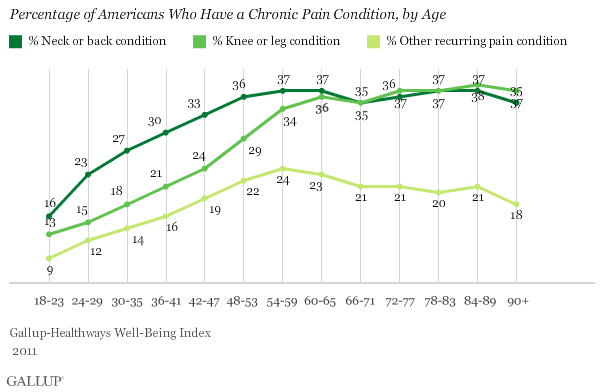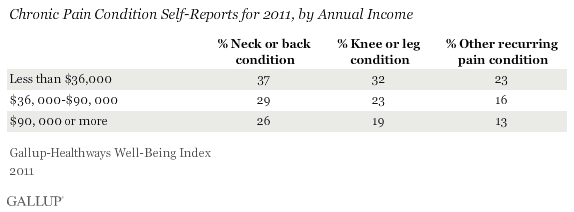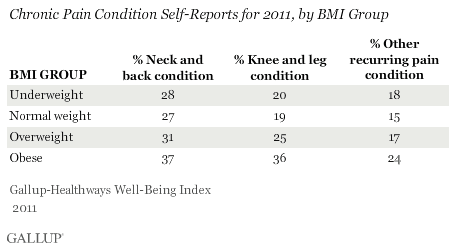WASHINGTON, D.C. -- More than one-third of Americans in their mid-50s and older have chronic pain in their neck or back, and a similar percentage report chronic knee or leg pain. Further, more than one in five adults in their late 40s through late 80s has some other type of recurring pain. Chronic pain conditions increase rapidly from about ages 25 to 60, after which reports of chronic pain increase only slightly or decrease.

These findings are based on 2011 Gallup-Healthways Well-Being Index daily tracking data, encompassing surveys with more than 353,000 U.S. adults, aged 18 and older. The resulting sample sizes for every five-year age group -- ranging from roughly 2,800 to 47,000 cases -- allow for a granular look at how chronic pain progresses as Americans age.
The Gallup-Healthways Well-Being Index measures the prevalence of chronic pain by asking respondents if they have a neck or back condition, a knee or leg condition, or another condition that caused recurring pain in the last 12 months.
Overall in 2011, an average of 31% of Americans reported having a neck or back condition, 26% had a knee or leg condition, and 18% had another condition causing recurring pain. Gallup finds similar rates each year since tracking began in 2008. In all, 47% of Americans reported having at least one of the three types of chronic pain measured in the survey, including 7% who reported all three types.
Americans' reports of chronic pain conditions increase most sharply from their mid-20s to late 50s. This is likely related to the repeated use of muscles, joints, and ligaments over time, as well as this age group's increased likelihood of being overweight or obese. A key finding, however, is that beginning at about age 60, rates of self-reported chronic pain level off and do not increase further, even as Americans move into their 70s, 80s, and 90s.
The percentage of Americans reporting they have a neck or back condition climbs steadily between the ages of 18 and 59, rising from 16% among 18- to 23-year-olds to 37% among 54- to 59-year-olds and then plateaus at about 36% among people ages 60 and older.
The pattern for knee and leg conditions is similar. Thirteen percent of 18- to 23-year-olds report this type of pain. It rises rapidly to 21% among those aged 36 to 41 years, then to 34% among those aged 54 to 59, and slightly increases to 38% among 84- to 89-year-olds.
The pattern is somewhat different for the percentage of Americans who report "other chronic pain conditions." The 9% of 18- to 23-year-olds who have other chronic pain conditions steadily increases to 24% among those in their late 50s, but then slowly declines to 18% among those ages 90 and older.
The rates would likely continue to compound into old age, except for the mortality rates associated with chronic pain conditions. According to the U.S. Centers for Disease Control and Prevention, 47% of people with arthritis have one comorbid condition such as heart disease, chronic respiratory conditions, diabetes, or stroke. It is possible that those who survive into their 70s and 80s are typically less likely to have such chronic pain conditions.
Low-Income Americans Much More Likely to Have Chronic Pain
Americans with an annual income of less than $36,000 are much more likely to report having chronic pain conditions than those with higher incomes. There is an 11-percentage-point difference in reports of neck and back pain between lower- and higher-income Americans, a 13-point difference for knee and leg pain, and a 10-point difference for other chronic pain conditions.

One possible reason for these variances by income is that lower-income individuals are much more likely to be uninsured. Without insurance, low-income individuals may not be able to afford medical care, physical therapy, and medication for their chronic pain conditions. Another reason is that lower-income Americans may be more likely to work in manual labor occupations such as cleaning, construction, and agriculture. Furthermore, lower-income respondents are more likely to be overweight or obese than higher-income individuals
Overweight, Obese More Likely to Report Chronic Pain
Those who are overweight or obese are much more likely to have a chronic pain condition than those who are underweight or maintain a normal weight. This difference supports Gallup Senior Scientist Arthur Stone's findings about the relationship between weight and chronic pain.
For example, 36% of obese Americans say they have a knee or leg condition compared with 19% of those who maintain a normal weight. Overweight and obese individuals place extra pressure on weight-bearing joints, such as the knees and hips, which may lead to chronic pain conditions like osteoarthritis.

There could be several additional explanations for the relationship between obesity and pain. As Dr. Stone outlined in his analysis of similar data, these include complex physiological processes that result in inflammation and chronic pain due to excess fat or depression. Medical conditions that cause chronic pain, such as arthritis, might also result in lower levels of exercise, thereby resulting in weight gain.
Bottom Line
Chronic pain afflicts a relatively small percentage of Americans in their late teens and early 20s, but increases sharply as adults enter middle age. By the time Americans are in their late 50s and older, more than one-third report chronic pain in their neck or back, with a similar percentage reporting such pain in their knee or leg. In addition, nearly one-quarter of Americans in their late 50s have other conditions that cause recurring pain. Self-reports of pain, however, appear to reach a threshold of sorts at about age 60 and do not increase significantly after that point.
Low-income and overweight Americans are significantly more likely to suffer from chronic pain conditions. Although age is a non-modifiable risk factor for chronic pain conditions, obesity is a risk factor that Americans can prevent through proper eating and exercise. It is possible that chronic pain conditions may directly cause sedentariness, which can lead to obesity and other chronic conditions. Therefore, Americans of all ages can use nutrition and exercise as ways to prevent or manage chronic pain conditions.
About the Gallup-Healthways Well-Being Index
The Gallup-Healthways Well-Being Index tracks well-being in the U.S., U.K., and Germany and provides best-in-class solutions for a healthier world. To learn more, please visit well-beingindex.com.
Survey Methods
Results are based on telephone interviews conducted as part of the Gallup Healthways Well-Being Index survey in 2011, with a random sample of 353,492 adults, aged 18 and older, living in all 50 U.S. states and the District of Columbia.
For results based on the total sample of national adults, one can say with 95% confidence that the maximum margin of sampling error is ±1 percentage points.
Interviews are conducted with respondents on landline telephones and cellular phones, with interviews conducted in Spanish for respondents who are primarily Spanish-speaking. Each sample includes a minimum quota of 400 cell phone respondents and 600 landline respondents per 1,000 national adults, with additional minimum quotas among landline respondents by region. Landline telephone numbers are chosen at random among listed telephone numbers. Cell phones numbers are selected using random digit dial methods. Landline respondents are chosen at random within each household on the basis of which member had the most recent birthday.
Samples are weighted by gender, age, race, Hispanic ethnicity, education, region, adults in the household, and phone status (cell phone-only/landline only/both, cell phone mostly, and having an unlisted landline number). Demographic weighting targets are based on the March 2011 Current Population Survey figures for the aged 18 and older non-institutionalized population living in U.S. telephone households. All reported margins of sampling error include the computed design effects for weighting and sample design.
In addition to sampling error, question wording and practical difficulties in conducting surveys can introduce error or bias into the findings of public opinion polls.
For more details on Gallup's polling methodology, visit https://www.gallup.com/.
